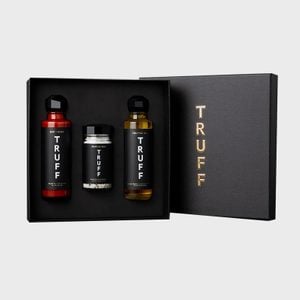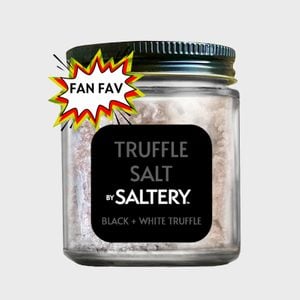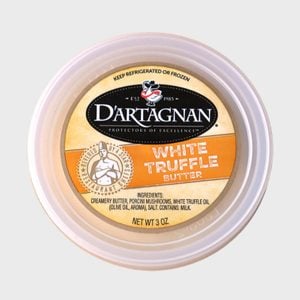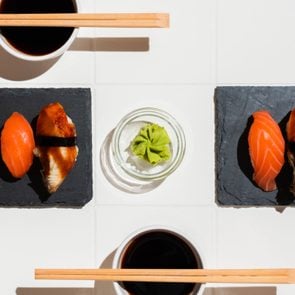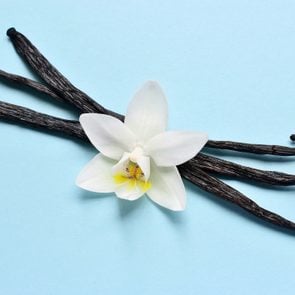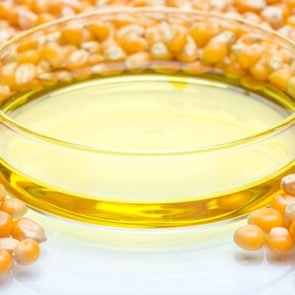What Are Truffles—and Why Do They Cost So Much?
Updated: Mar. 20, 2023
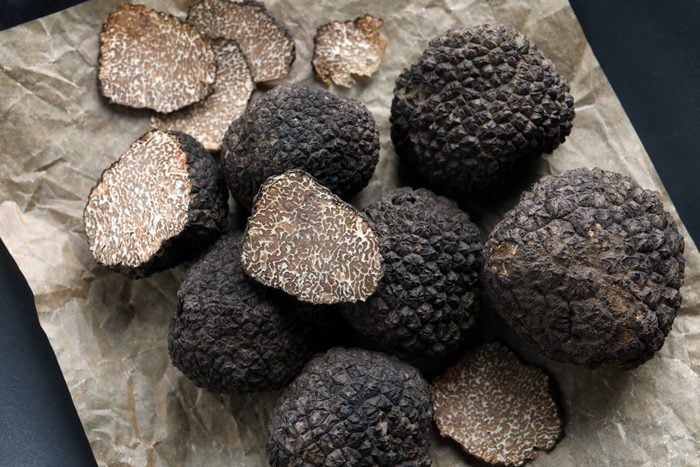
Here's everything you need to know about what a truffle is and why this luxury ingredient is so darn expensive
When it comes to savory foods, there’s nothing more delicious and decadent than truffles. Most people know the basic food facts about these fungi. They’re rare and expensive, much like caviar and saffron. They’re packed with umami, the rich, savory flavor that gives things like steaks and mushrooms their signature taste. And when infused in oil, they make a lip-smackingly good drizzle for french fries. But what is a truffle, exactly?
Let’s delve into the specifics of truffles: what they are, how they’re found and how to eat them. Truffles are a taste of the good life, and you deserve to indulge in the finer things every once in a while.
Get Reader’s Digest’s Read Up newsletter for more food, humor, cleaning, travel, tech and fun facts all week long.
What is a truffle, exactly?
Truffles are rare, edible subterranean fungi in the genus Tuber. Like mushrooms, they belong to the Fungus kingdom. But unlike mushrooms, which grow aboveground, truffles live beneath the earth and grow in the dark.
They’re generally small and lumpy, with a bumpy exterior. Although truffles tend to look somewhat similar, the different species range in color from black and brown to white and even red. The most well-known species are winter white, winter black, muscat black, musky black, Chinese black, Himalayan black, summer black, autumn black and white truffles. But there are plenty of other varieties and subvarieties.
A word to the wise: Just because it’s a truffle doesn’t mean it’s worth eating. Even though they are edible, some truffles taste awful or have no taste at all. (That may be why truffle oil is one of the foods professional chefs like the least.)
What do truffles taste like?
Both black and white truffles are true umami bombs, with an overwhelming savory flavor. That said, a truffle’s specific flavor depends on the type of truffle, where it grew, if it’s raw or cooked and the type of recipe it appears in.
Black truffles have an earthy flavor, with a slightly bitter aftertaste and notes of nuttiness. They have a pungent, musky aroma that some experts compare to a damp forest floor. White truffles are similar to but much milder than their black counterparts. Their musky aroma is far fainter, with a subtle nuttiness and an almost sweet flavor.
If you can afford the real deal, remember that the longer they’re out of the ground, the quicker truffles lose their signature smell and flavor.
Why are truffles so expensive?
People pay serious money for truffles because they prize the fungi’s aroma and flavor. Still, not all truffles are equal.
Black truffles are more affordable because they have a longer season, are freezable and are more common than other varieties. That’s why you can find budget-friendly options like these truffle thrills. White truffles are more expensive since they’re rare, have a short season, don’t freeze well and pack a seriously flavorful punch.
As with all produce, the price varies depending on the season and the quality of the annual crop. In 2021, the rarest black truffles, like the Burgundy black truffle, went for nearly $900 per pound, while more common truffles, like the Chinese black truffle, ran for less than $100 a pound. Meanwhile, European white truffles can sell for as much as $3,300 a pound!
There are a few other reasons truffles are so expensive. How they grow and how we find and handle them all play a role in the end price.
Farmers can’t simply plant them
Unlike corn, truffles aren’t something people can easily plant, farm or harvest—they’re wild and picky about where they grow. Truffles usually flourish in places where warm days see moisture and nights are cool. They also prefer growing near certain types of trees, including oak, pine and hazel. The Italian and French countrysides are especially popular growing spots, but some species grow in the Pacific Northwest and Australia too.
They’re slow growers
Truffles aren’t quick crops or the sort of food item that lasts for a while. For starters, they grow slowly. In fact, some reports say it takes four to six years for some types of truffles to grow. On top of that, they have short seasons and don’t last long once out of the ground.
They’re tough to find
Let’s say a truffle has crossed the first two hurdles and grown into a mature tuber. The next step is finding it—which is no easy feat.
As truffles mature, they naturally release smelly compounds, but they’re not pungent enough for human noses. That’s why “hunters” rely on animals with great senses of smell to help track down the tubers. The modern truffle hunter’s go-to helper is man’s best friend. Compared with other animals, trained dogs don’t just get the job done, they do it well.
The process is labor intensive
Plucking truffles from the ground isn’t a quick and easy process. After truffle dogs sniff them out, hunters must carefully dig them from the ground to avoid damaging the delicate tubers. It’s a labor-intensive process, helping explain why truffles are such an expensive or even overpriced food.
Are pigs really used to find truffles?
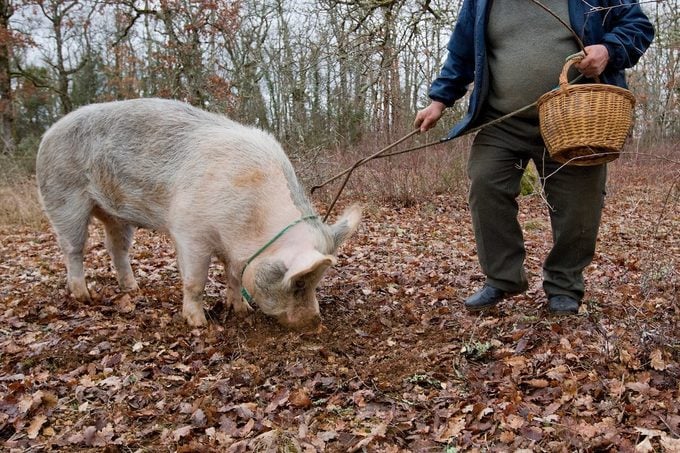
Remember how truffles release a pungent odor that’s too faint for our sense of smell? That’s where truffle pigs come in.
So, what are truffle pigs? They’re the swine traditionally used to search out truffles. Because they have a highly developed sense of smell, female pigs were the truffle-hunting animal of choice back in the day.
But there’s a reason beyond their sensitive oinkers that female pigs, in particular, were appointed to the task: Truffles contain androstenol, a sex hormone found in the saliva of male pigs. Female pigs are naturally drawn to even the slightest whiff of androstenol, which made them ideal hunters.
Today, pigs are no longer the preferred assistant of most truffle hunters, as they’re difficult to control and have a nasty habit of destroying the truffles while enthusiastically digging them up. And it’s not just the truffles that are in danger—pigs’ hooves can damage the ground to such an extent that fewer truffles grow in that soil afterward. In fact, the use of pigs for truffle hunting has been banned in Italy since 1985 to protect the country’s lucrative truffle-growing terrain.
But there’s another reason truffle hunters have moved away from the animal: Pigs have a tendency to, well, pig out. They like to eat the truffles once they’ve unearthed them. (When you’re searching for something that costs thousands of dollars, you don’t want an unruly pig to eat your prize!)
While some foragers still use truffle-hunting hogs, most have turned to a more well-behaved animal. Specially trained dogs are easier to control, dig more gently and—most important—don’t eat the truffles once they’ve dug them up.
What’s the best way to eat truffles?
You’re going to want to eat these sparingly—what is a truffle if not a luxury ingredient? Fortunately, they’re so potent that a little goes a long way.
What are truffles used for in cooking? These are just a few of the best ways to eat the flavorful fungi:
- Truffles pair wonderfully with eggs of all sorts. Try shaving some over softly scrambled eggs, or add a bit of truffle butter to the pan while cooking.
- Shave raw truffles over simply prepared pasta or risotto. When using truffles, you want to let them shine, so don’t overdo it with additional ingredients—a bit of butter, salt and some good hard cheese is more than enough.
- Make a rich sauce for chicken, fish, steak or vegetables by gently cooking a few tablespoons of truffle-infused oil or butter with a cup of heavy cream, a splash of white wine and a bit of salt and pepper to taste. Want more truffle flavor? Add a bit more butter or fresh truffle shavings!
What is truffle oil?
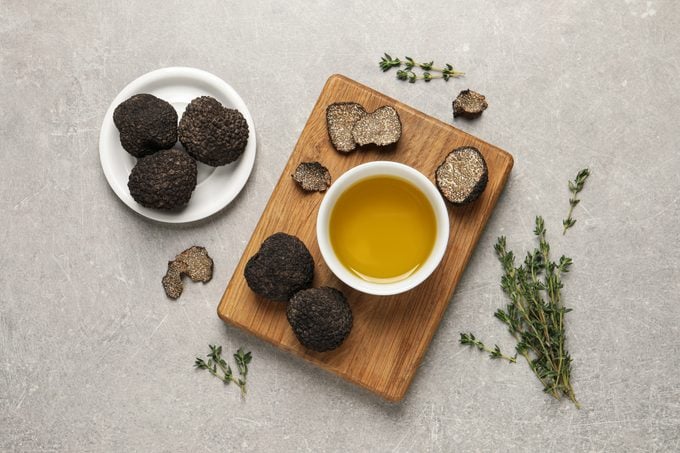
To make your truffle haul last longer, you can infuse the tasty tubers into oil or butter, which you can cook with or drizzle over food, creating masterpieces like truffle fries. (What are truffle fries? An addictive combo of crispy, salty french fries and rich umami truffle oil.) The process is easy—just follow the steps below.
Make truffle oil or butter in a pan:
- In a small saucepan over low heat, gently cook 2/3 cup oil or butter with about 1 tablespoon shaved truffle until it reaches about 130 degrees.
- Cover the pan and remove it from the heat.
- Allow your infusion to cool to room temperature.
- Pour it into a glass jar (no need to strain!) and seal it tightly.
- Store the truffle oil in a cool, dark cabinet for up to six months. Store the butter in the refrigerator for up to three months, or freeze it for up to a year.
Make truffle oil in a jar:
- Put 1 to 2 tablespoons of shaved truffles into a glass jar.
- Add 1 cup of oil (olive and grape-seed oils are best).
- Seal the jar tightly.
- Stash it in a cool, dark place for one week.
Beware the truffle oil imposters
What is truffle oil made of? Sounds like an easy question, right? While the methods above will give you truffle oil made from truffles, don’t assume that’s the case with store-bought oils. Most commonly available brands don’t actually contain any truffles, which is why many chefs absolutely refuse to cook with truffle oil.
Instead of truffles, these oils are blended with a lab-made chemical compound called 2,4-dithiapentane. Though it’s naturally found in truffles, the compound is only one of the many, many molecules that give truffles their incomparable flavor.
“More times than not, they don’t have any relation to the actual taste of truffle but are becoming more common with the public because they are an even cheaper option than the already relatively affordable truffle oils,” said William Eick, a chef at Mission Avenue Bar and Grill in Oceanside, California. “They also give the guest a false sense of flavor for them once they encounter true truffles.”
There are plenty of truffle oils, salts and butters on the market that do, in fact, contain truffles. But it’s important to look at the ingredient label before purchasing so you don’t end up getting duped. Here are some of our favorite authentic truffle products you can purchase online:
Do chocolate truffles have any relation to truffle mushrooms?
The two foods may share the same name, but that’s about it! So what are chocolate truffles, and why do they share a name with fungi?
Chocolate truffles likely got their name because of their resemblance to freshly unearthed black truffles. Like everyone’s favorite tuber, they’re dark and round, though you’ll also find white chocolate truffles that resemble the lighter-colored truffle varieties.
But specifically what are truffles made of? To make a traditional candy truffle, chocolatiers first mix melted chocolate with heavy cream and flavorings to create a ganache. After it cools, they scoop the soft, pliable mixture into balls and then roll it in Dutch-processed cocoa powder.
Are truffles healthy?
Truffles contain a number of vitamins and minerals, including vitamin C, potassium and iron. That said, truffles are rarely consumed in large enough quantities to have any sort of health benefits.
By now, you should be able to answer “What is a truffle?” Brush up on other food facts by learning what tahini is and how to tell the difference between stock and broth.
Sources:
- William Eick, chef at Mission Avenue Bar and Grill in Oceanside, California
- Utah State University: “Gold in the Soil”
- Dallas Observer: “Why Those Black Truffles You’re Eating Don’t Taste Like Truffles at All”
- Science Friday: “On the Oregon Truffle Scent”
- Good Food: “From Tomatoes to Truffles: Backyard Gardeners Set Their Eyes on a Bigger Prize”
- New York Times: “Buried Treasure That Is Filled with Mystery”
- Truffle.Farm: “Truffle Price Tracker”
- Urbani Truffes: “Truffle Hunting 101”

